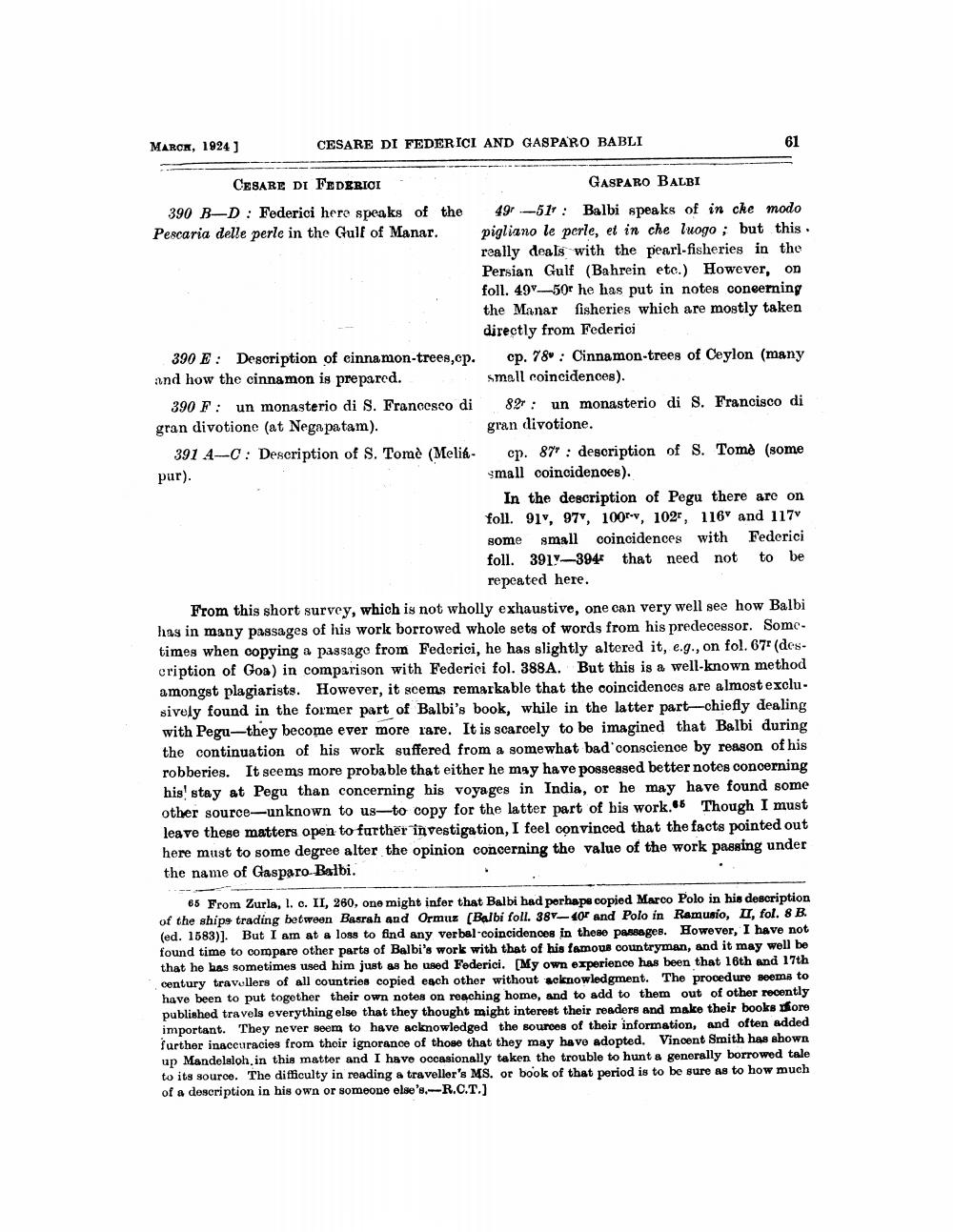________________
MARCH, 1924)
CESARE DI FEDERICI AND GASPARO BABLI
CESARE DI FEDERICI
GASPARO BALBI 390 B-D: Federici here speaks of the 49-511 : Balbi speaks of in che modo Pescaria delle perle in the Gulf of Manar. pigliano le perle, et in che luogo; but this
really deals with the pearl-fisheries in the Persian Gulf (Bahrein etc.) However, on foll. 499–50 he has put in notes concerning the Manar fisheries which are mostly taken
directly from Federici 390 E: Description of cinnamon-trees,cp. cp. 78: Cinnamon-trees of Ceylon (many and how the cinnamon is prepared.
small coincidences). 390 F : un monasterio di S. Francesco di 827 : un monasterio di S. Francisco di gran divotione (at Nega patam).
gran divotione. 3914--C: Description of S. Tome (Melik- ep. 87" : description of S. Tome (some pur).
small coincidences).
In the description of Pegu there are on foll. 91, 975, 100r-v, 102, 116 and 117 some small coincidences with Federici foll. 3911–3945 that need not to be
repeated here. From this short survey, which is not wholly exhaustive, one can very well see how Balbi has in many passages of his work borrowed whole sets of words from his predecessor. Somotimes when copying a passage from Federici, he has slightly altered it, e.g., on fol. 67' (description of Goa) in comparison with Federici fol. 388A. But this is a well-known method amongst plagiarists. However, it seems remarkable that the coincidences are almost exclu. sively found in the former part of Balbi's book, while in the latter part-chiefly dealing with Pegu—they become ever more rare. It is scarcely to be imagined that Balbi during the continuation of his work suffered from a somewhat bad conscience by reason of his robberies. It seems more probable that either he may have possessed better notes concerning his stay at Pegu than concerning his voyages in India, or he may have found some other source-unknown to us—to copy for the latter part of his work. Though I must leave these matters open to further investigation, I feel oonvinced that the facts pointed out here must to some degree alter the opinion concerning the value of the work passing under the name of Gasparo Balbi.
65 From Zurla, 1. c. II, 260, one might infer that Balbi had perhape copied Marco Polo in his description of the shipe trading between Basrah and Ormuz (Balbi foll. 38V--for and Polo in Ramusio, II, fol. 8 B. (ed. 1583)]. But I am at a loss to find any verbal-coincidences in these pamages. However, I have not found time to compare other parts of Balbi's work with that of his famous countryman, and it may well be that he has sometimes used him just as he used Federici. [My own experience has been that 16th and 17th century travellers of all countries copied each other without acknowledgment. The procedure seems to have been to put together their own notes on reaching home, and to add to them out of other recently published travels everything else that they thought might interest their readers and make their books ore important. They never seem to have acknowledged the sources of their information, and often added further inaccuracies from their ignorance of those that they may have adopted. Vincent Smith has shown up Mandelsloh in this matter and I have occasionally taken the trouble to hunt & generally borrowed tale to its source. The difficulty in reading a traveller's MS. or book of that period is to be sure as to how much of a description in his own or someone else's.-R.C.T.)




